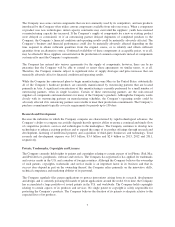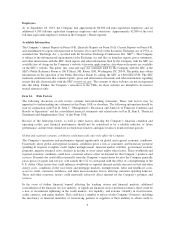Apple 2013 Annual Report Download - page 18
Download and view the complete annual report
Please find page 18 of the 2013 Apple annual report below. You can navigate through the pages in the report by either clicking on the pages listed below, or by using the keyword search tool below to find specific information within the annual report.environmental laws, labor laws, and anti-competition regulations, increases the costs of doing business in foreign
jurisdictions. Although the Company has implemented policies and procedures to comply with these laws and
regulations, a violation by the Company’s employees, contractors, or agents could nevertheless occur.
The Company also could be significantly affected by other risks associated with international activities including,
but not limited to, economic and labor conditions, increased duties, taxes and other costs, and political instability.
Margins on sales of the Company’s products in foreign countries, and on sales of products that include
components obtained from foreign suppliers, could be materially adversely affected by international trade
regulations, including duties, tariffs and antidumping penalties. The Company is also exposed to credit and
collectability risk on its trade receivables with customers in certain international markets. There can be no
assurance the Company can effectively limit its credit risk and avoid losses.
The Company’s Retail segment has required and will continue to require a substantial investment and
commitment of resources and is subject to numerous risks and uncertainties.
The Company’s retail stores have required substantial investment in equipment and leasehold improvements,
information systems, inventory and personnel. The Company also has entered into substantial operating lease
commitments for retail space. Certain stores have been designed and built to serve as high-profile venues to
promote brand awareness and serve as vehicles for corporate sales and marketing activities. Because of their
unique design elements, locations and size, these stores require substantially more investment than the
Company’s more typical retail stores. Due to the high cost structure associated with the Retail segment, a decline
in sales or the closure or poor performance of individual or multiple stores could result in significant lease
termination costs, write-offs of equipment and leasehold improvements, and severance costs.
Many factors unique to retail operations, some of which are beyond the Company’s control, pose risks and
uncertainties. These risks and uncertainties include, but are not limited to, macro-economic factors that could
have an adverse effect on general retail activity, as well as the Company’s inability to manage costs associated
with store construction and operation, the Company’s failure to manage relationships with its existing retail
channel partners, more challenging environments in managing retail operations outside the U.S., costs associated
with unanticipated fluctuations in the value of retail inventory, and the Company’s inability to obtain and renew
leases in quality retail locations at a reasonable cost.
Investment in new business strategies and acquisitions could disrupt the Company’s ongoing business and
present risks not originally contemplated.
The Company has invested, and in the future may invest, in new business strategies or acquisitions. Such
endeavors may involve significant risks and uncertainties, including distraction of management from current
operations, greater than expected liabilities and expenses, inadequate return of capital, and unidentified issues not
discovered in the Company’s due diligence. These new ventures are inherently risky and may not be successful.
The Company’s business and reputation may be impacted by information technology system failures or network
disruptions.
The Company may be subject to information technology system failures and network disruptions. These may be
caused by natural disasters, accidents, power disruptions, telecommunications failures, acts of terrorism or war,
computer viruses, physical or electronic break-ins, or other events or disruptions. System redundancy may be
ineffective or inadequate, and the Company’s disaster recovery planning may not be sufficient for all
eventualities. Such failures or disruptions could prevent access to the Company’s online stores and services,
preclude retail store transactions, compromise Company or customer data, and result in delayed or cancelled
orders. System failures and disruptions could also impede the manufacturing and shipping of products, delivery
of online services, transactions processing and financial reporting.
16
























